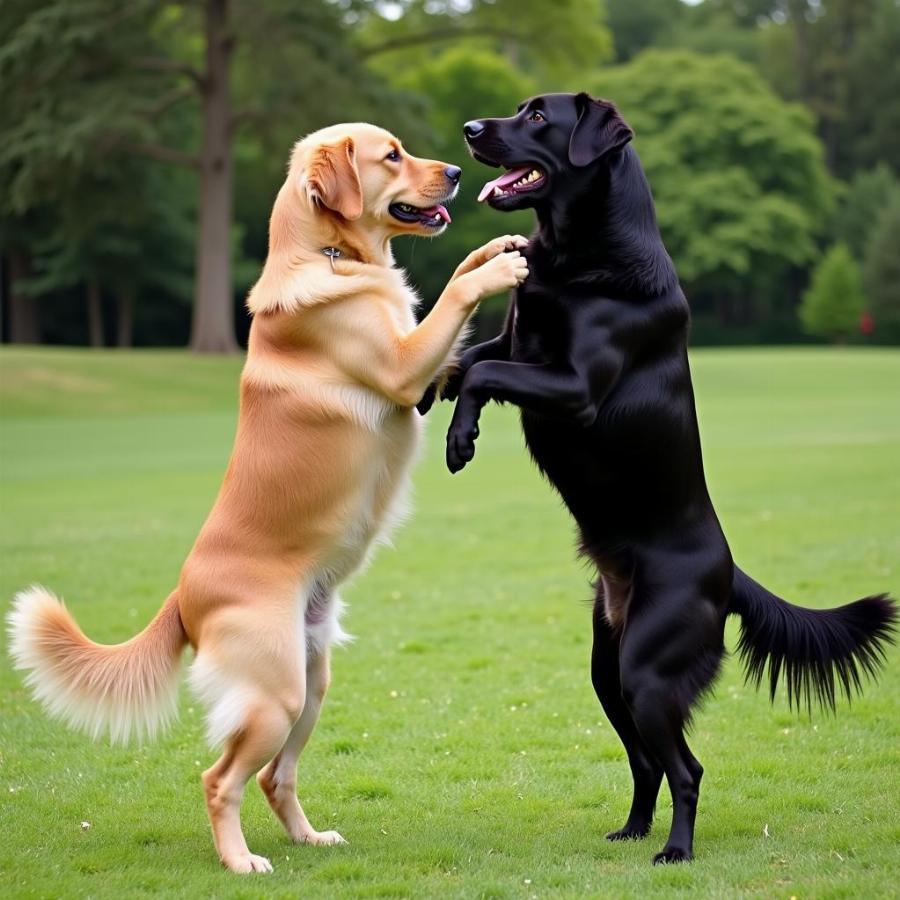Is your canine companion a frequent stretcher and bower? While these actions are often signs of a happy and healthy dog, it’s natural for pet parents to wonder about the specific reasons behind their furry friend’s behavior. In this article, we’ll delve into the world of doggy stretches and bows, exploring the various reasons why your dog might be engaging in these actions and what they could be trying to communicate.
Understanding Canine Body Language
Dogs primarily communicate through body language, and understanding these signals is key to building a strong bond with your pet. While barking, whining, and growling are vocalizations with clear meanings, subtle cues like stretching and bowing can easily be misinterpreted.
The “Good Stretch”: A Sign of Contentment and More
You’ve probably witnessed your dog waking up from a nap and performing a full-body stretch, often accompanied by a satisfying yawn. This “good stretch” is a natural instinct in dogs, just like in humans, helping to:
- Relieve Stiffness: After periods of rest, stretching helps increase blood flow to muscles, reducing stiffness and preparing the body for activity.
- Improve Flexibility: Regular stretching can improve your dog’s range of motion and flexibility.
The Play Bow: An Invitation to Fun
A play bow is a distinct type of stretch where your dog lowers their chest to the ground while keeping their rear end raised. This posture is a clear signal for:
- Playtime: The play bow is a universal invitation to play among dogs, letting their playmates know their intentions are friendly and fun.
- Stress Relief: Some dogs use play bows as a way to diffuse tense situations or simply to release pent-up energy.
 Two Dogs Playing Bow
Two Dogs Playing Bow
Other Reasons for Stretching and Bowing
While stretching and bowing often indicate positive emotions, it’s crucial to consider the context of your dog’s behavior.
- Attention Seeking: If your dog feels ignored, they might try to get your attention by stretching or bowing in front of you.
- Medical Concerns: In some cases, frequent stretching could be a sign of underlying health issues such as arthritis or gastrointestinal discomfort.
“If you notice any changes in your dog’s stretching habits, especially if accompanied by other symptoms like lethargy, loss of appetite, or limping, it’s essential to consult with your veterinarian,” advises Dr. Emily Parker, a certified veterinary behaviorist.
Responding to Your Dog’s Stretches and Bows
- Reciprocate the Playfulness: If your dog initiates a play bow, engage them! Grab their favorite toy and enjoy some quality playtime.
- Provide Comfort and Reassurance: If you suspect your dog’s stretching is due to stress or anxiety, offer them comfort and reassurance through gentle petting and a calm voice.
- Seek Professional Help When Needed: If you notice any unusual or concerning stretching behaviors, don’t hesitate to reach out to your veterinarian or a certified dog trainer for guidance.
Conclusion
Understanding your dog’s body language is essential for building a strong and fulfilling relationship. Stretching and bowing are common behaviors with a range of meanings, mostly positive. By paying attention to the context of these actions and recognizing the accompanying cues, you can better understand your furry friend’s needs and emotions.
FAQs
1. Why does my dog stretch in front of me?
Dogs often stretch in front of their owners as a sign of affection, a request for attention, or an invitation to play.
2. Is it normal for my dog to stretch frequently?
Occasional stretching is perfectly normal for dogs. However, if you notice excessive or unusual stretching, it’s best to consult your veterinarian to rule out any medical concerns.
3. How can I tell if my dog is stretching due to pain?
Stretching accompanied by other symptoms like whining, limping, or changes in appetite could indicate pain. If you suspect your dog is in discomfort, contact your vet immediately.
4. Can I encourage my dog to stretch?
You can incorporate gentle stretches into your dog’s playtime or daily routine, but avoid forcing them into any uncomfortable positions.
5. What should I do if my dog’s stretching behavior suddenly changes?
Any sudden changes in your dog’s behavior warrant a visit to the vet. These changes could indicate an underlying health issue or a change in their emotional state.
Need More Advice?
Beaut Dogs is your ultimate resource for all things dog-related, providing reliable and insightful information about the wonderful world of canine companions. From breed-specific guides to expert advice on training, nutrition, and care, we’re here to help you navigate the joys and challenges of dog ownership. For personalized support and answers to your most pressing dog-related questions, reach out to us at [email protected]. We’re always happy to help!